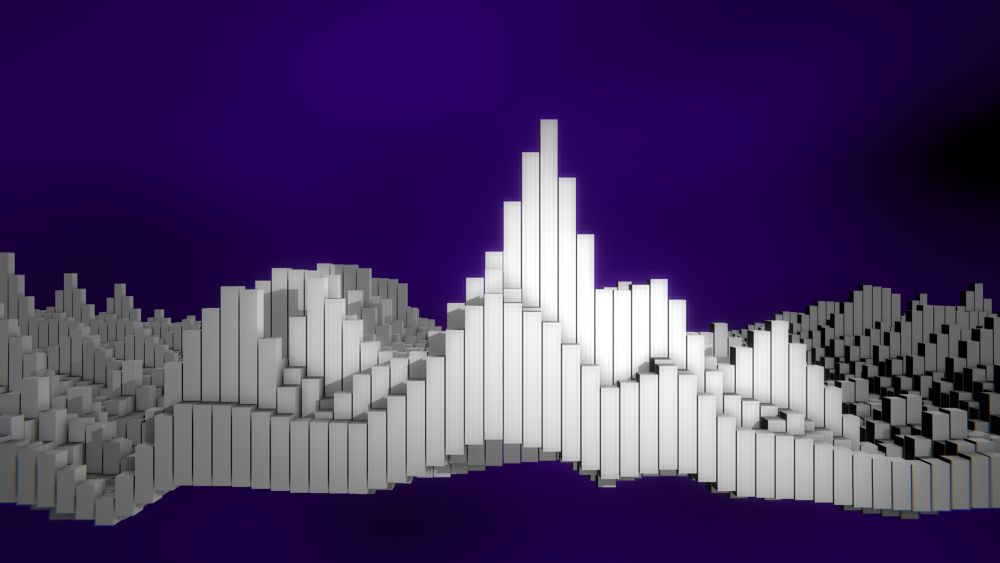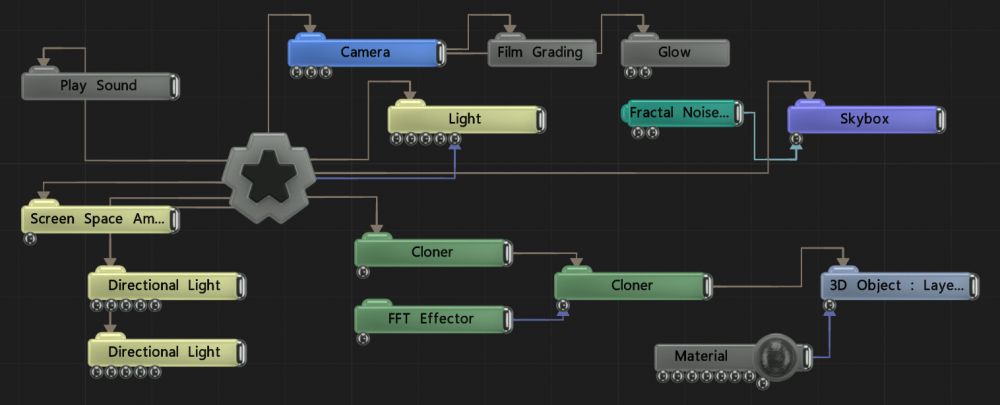FFT Effector
Modifies a cloner system using an audio input.



This node applies a transform to clones based on the analysis of an audio source. The waveform is processed using a set of parameters, allowing for greater control over how the sound is applied to the clones.
Connect the output to the effector input of any cloner node to apply it to the camera system. Multiple effectors connected to the same output will stack, and order of operations chosen by position on the nodegraph.
These properties control the 3D transforms of the node. Transforms will generally be inherited by child nodes, although they can be ignored through the Inherit Transform Channels attributes.
| Parameter | Details |
|---|---|
| Position X | Move along the local x-axis. |
| Position Y | Move along the local y-axis. |
| Position Z | Move along the local z-axis. |
| Rotation Heading | Rotate around the local y-axis. |
| Rotation Pitch | Rotate around the local x-axis. |
| Rotation Bank | Rotate around the local z-axis. |
| Scale X | Scale along the local x-axis. |
| Scale Y | Scale along the local y-axis. |
| Scale Z | Scale along the local z-axis. |
Toggle which transform channels should be inherited from the parent node. By default, all transforms will be inherited.
| Parameter | Details |
|---|---|
| Position X | Toggle inheritance of the X Position from the parent. |
| Position Y | Toggle inheritance of the Y Position from the parent. |
| Position Z | Toggle inheritance of the Z Position from the parent. |
| Rotation Heading | Toggle inheritance of the Rotation Heading from the parent. |
| Rotation Pitch | Toggle inheritance of the Rotation Pitch from the parent. |
| Rotation Bank | Toggle inheritance of the Rotation Bank from the parent. |
| Scale X | Toggle inheritance of the X Scale from the parent. |
| Scale Y | Toggle inheritance of the Y Scale from the parent. |
| Scale Z | Toggle inheritance of the Z Scale from the parent. |
| World Position Only | Inherit the world position from the parent only, rotation and scale will be ignored. Overrides above properties. |
| Inherit Time | Toggle inheritance of time from the parent. |
These properties control the core behaviours of the node.
| Parameter | Details |
|---|---|
| Blend Amount | Controls the amount the resulting transforms of each clone after the effector is applied is blended with the original transform. |
| Space | The transform space the Effector uses to influence the clones.
|
| Sound | Sound used to drive the effector. Can be overwritten by adding a relevant node to the Sound input. |
| Channel | Which audio channel is used. |
| Frequency Band | Sets the Band EQ to one of the given presets. |
| Band EQ | Selects and weights the frequency bands to be used from the sound file. |
| Time Offset | Offset the time the clones are modified from the time the waveform is at. |
| Change Threshold | Changes the threshold for what counts toward the effect. |
| Attack | Controls the initial time between the current values to the peak. |
| Decay | Controls the time between the peak to the sustain level. |
| Min Value | Acts as a minimum threshold for extracting a range of values from the waveform. |
| Max Value | Acts as a maximum threshold for extracting a range of values from the waveform. |
| Max Clamp | A maximum value which values will be clamped if they go above. |
| Spikiness | Accentuates peaks in the waveform so they are sharper. |
| Scale | How much the output values are scaled. |
| Smoothness | How much smoothing is applied between differing values. |
| FFT Sample Scale | Scale the size of the waveform as it is applied. |
| Waveform | Visualises the waveform of of the sound. |
| Direction | Change how the sound is applied to the Cloner system.
|
These properties control where an effector can affect the clones.
| Parameter | Details |
|---|---|
| Falloff Mode | Change how the falloff from the original object is calculated.
|
| Linear Falloff Axis | The falloff axis to use when the effector is in linear mode.
|
| Falloff | The outer radius of the falloff, where the effector no longer effects the clones. |
| Inner Falloff | The inner radius of the falloff, where the effector effects the clones strongest. |
| Falloff Power | Change how quickly the nodes falloff from the effector |
| Falloff Size | The X size of the falloff when in box mode. |
| Invert Falloff | Invert the direction of the falloff. |
These properties control how an effector transforms the clones.
| Parameter | Details |
|---|---|
| Position X | Offset the clones x position from the current position. |
| Position Y | Offset the clones y position from the current position. |
| Position Z | Offset the clones z position from the current position. |
| Rotation Heading | Offset the clones y rotation from the current rotation. |
| Rotation Pitch | Offset the clones z rotation from the current rotation. |
| Rotation Bank | Offset the clones x rotation from the current rotation. |
| Scale X | Offset the clones x scale from the current scale. |
| Scale Y | Offset the clones y scale from the current scale. |
| Scale Z | Offset the clones z scale from the current scale. |
| Uniform Scale | Uniformally scale the clones by the same value along all axes. |
| Position Apply Mode | The method by which the effectors position properties are applied to the clone.
|
| Rotation Apply Mode | The method by which the effectors rotation properties are applied to the clone.
|
| Scale Apply Mode | The method by which the effectors scale properties are applied to the clone.
|
| Name | Description | Typical Input |
|---|---|---|
| Sound | Use an input sound to override the sound attribute. | Play Sound |
| Procedural Falloff | Use a procedural system to generate falloff from. Useful for creating complex and unconventional falloffs from an Effector. | Procedural Root |
| Transform Modifiers | Apply the transforms of another node to this node. | Null |
| Target Node | Modifiy the rotations of the node to always direct the z axis towards the input. | Null |
| Local Transform Override | Apply the transforms of another node to this node, relative to its parent. | Null |